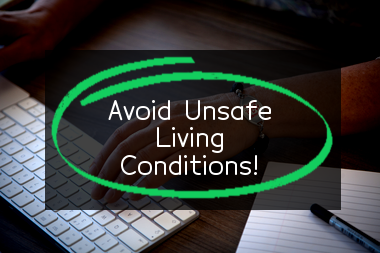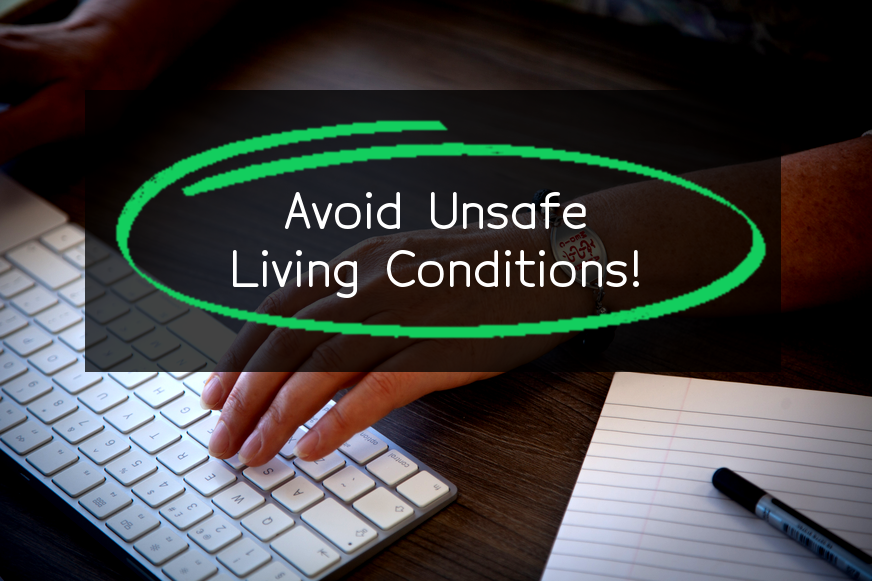Landlords have a legal obligation to provide safe and healthy living conditions for their tenants. Unsafe property living conditions can cause harm to tenants and can lead to legal problems for landlords. The following are six top unsafe property living conditions that landlords must avoid:
- 1. Mold and Moisture: Mold and moisture can cause respiratory problems, allergies, and other health issues. Landlords must ensure that their properties do not have excessive moisture levels and should repair any leaks or water damage as soon as possible.
- 2. Inadequate Heating: Lack of proper heating can cause cold-related health complications such as pneumonia, hypothermia, and frostbite. Landlords are required to provide sufficient heating to ensure their tenants stay warm in the winter.
- 3. Pest Infestations: Pests such as rodents and insects can carry diseases and cause property damage. Landlords should take measures to prevent pest infestations and should respond quickly if tenants report any signs of infestations.
- 4. Electrical Hazards: Electrical hazards such as exposed wires, faulty wiring, and overloaded circuits can lead to property damage and can cause fires. Landlords should ensure that their properties are up to electrical standards and that any repairs are done promptly.
- 5. Unsafe Structures: Unsafe structures such as broken stairs, loose railings, and other hazards can lead to falls and other injuries. Landlords should regularly inspect properties to identify and repair any unsafe structures.
- 6. Poor Air Quality: Poor air quality can cause respiratory issues and other health problems. Landlords should ensure that their properties have adequate ventilation and fresh air circulation to maintain healthy air quality.
In Summary, landlords have a legal obligation to provide safe and healthy living conditions for their tenants. Landlords must avoid the 6 top unsafe property living conditions which are Mold and Moisture, Inadequate Heating, Pest Infestations, Electrical Hazards, Unsafe Structures, and Poor Air Quality to ensure their tenants' safety and avoid legal problems.
What does uninhabitable mean?
When using the term "uninhabitable" in the context of real estate, it refers to a property that cannot be safely occupied or utilized as a living space. Such a property may either be in a state of severe disrepair, or it may have undergone extensive damage due to a disaster such as fire or flood. Properties that are uninhabitable may also have structural issues, plumbing problems, or electrical issues that make them unsafe for human habitation.
In most cases, uninhabitable properties are not suitable for living in, and cannot be rented, leased, or sold until they have undergone significant repairs and improvements. The process of restoring an uninhabitable property can be lengthy and costly, and it often requires the expertise of contractors, engineers, plumbers, etc.
There are several factors that can render a property uninhabitable, including:
- 1Lack of utilities such as electricity, water, or gas
- 2Presence of hazardous material such as mold, asbestos, or lead paint
- 3Inadequate heating, ventilation, or air conditioning (HVAC) system
- 4Damage caused by natural disasters such as floods or earthquakes
- 5Codes and regulations non-compliant issues
- 6Lack of proper insulation or structural issues.
In summary, when a property is deemed uninhabitable, it means that it is not safe or suitable for human habitation, and it requires significant repairs before it can be used as a living space.
Unsafe living conditions that landlords must avoid
Landlords are responsible for ensuring that their tenants have safe and habitable living conditions. Unsafe living conditions can cause health hazards, accidents, or other problems that can be detrimental to the tenant's well-being. Some of the unsafe living conditions that landlords must avoid are:
- 1Inadequate Heating and Cooling: Landlords must ensure that rental units have proper heating and cooling systems. If the unit is too hot or cold, it can cause health issues or even lead to death.
- 2Electrical Hazards: Tenants can suffer from electrical shocks or fires if the electrical systems in a rental unit are not safe. Landlords must ensure that electrical wiring and circuits are safely installed, and the electrical panel is up to code.
- 3Mold and Mildew: Mold and mildew can grow in damp areas such as bathrooms and basements which can lead to serious health problems such as asthma, allergies, and respiratory infections. Landlords must remediate any mold or mildew growth immediately and fix any underlying moisture problems.
- 4Pest Infestations: A rental unit with a pest infestation can cause a lot of discomfort and health issues for the tenants. Landlords have a legal obligation to ensure that the property is free from pests and to take appropriate measures to eradicate any infestations.
- 5Lack of Proper Ventilation: Proper ventilation is necessary to ensure good air quality indoors. Lack of proper ventilation can lead to a buildup of carbon monoxide, which can cause serious illness or even death.
- 6Structural Issues: Structural issues such as broken windows, loose railings or stairs, or damaged roofs can cause accidents and pose serious safety risks. Landlords must ensure that the rental unit is structurally sound and safe for tenants to occupy.
- 7Lack of Sanitation: Lack of sanitation can lead to the spread of disease, bacteria, and germs. Landlords must ensure that the unit has proper sanitation facilities, such as functional bathrooms and a clean environment.
In conclusion, landlords have a legal and moral obligation to ensure that their tenants are living in safe and habitable living conditions. Any unsafe living conditions must be remedied immediately to avoid any potential liability issues for the landlord.
Are landlords responsible for all repairs?
The responsibility of a landlord depends on different factors, including the type of repair, the lease agreement, and state and local laws. Here is a detailed explanation of the landlord's responsibilities for repairs:
- 1Basic Repairs: Landlords are responsible for basic repairs that affect the tenant's health and safety. This includes maintenance and repair of electrical, plumbing, heating, and air conditioning (HVAC) systems. The landlord must also ensure that the property is free from pests and hazards such as mold, asbestos, or lead-based paint.
- 2Structural Repairs: If the property's structure or foundation is damaged, the landlord is responsible for repairing it. These repairs may include fixing a leaky roof, cracking walls, or a broken foundation.
- 3Appliances and Fixtures: Landlords are responsible for maintaining appliances and fixtures that came with the rental property. This includes items like refrigerators, stoves, dishwashers, and bathroom fixtures. However, if the tenant causes damage to these items, they may be responsible for repairs.
- 4Minor Repairs: Landlords are not responsible for minor repairs that are purely cosmetic and do not affect the tenant's health and safety. This includes repair of broken blinds, chipped paint, or small holes in the wall.
- 5Lease Agreements: The lease agreement between a landlord and tenant may outline specific repair responsibilities. For example, the lease may state that the tenant must take care of minor repairs, while the landlord is responsible for all major repairs.
- 6State and Local Laws: Landlord responsibilities for repairs vary by state and local laws. Some jurisdictions require landlords to maintain rental properties in habitable conditions, while others place more responsibility on tenants. It's important to understand the laws in your area to determine the exact responsibility of landlords for repairs.
In summary, landlords are responsible for maintaining a safe and habitable rental property. However, the exact responsibility for repairs may vary depending on the type of repair, the lease agreement, and state and local laws.
When tenants can sue landlords for unsafe living conditions
Tenants have the legal right to expect a safe and habitable living environment from their landlords. If landlords fail to maintain this requirement, tenants may have legal grounds to sue them for unsafe living conditions. Here are some situations where tenants can sue landlords for unsafe living conditions:
- 1Health hazards: Landlords are responsible for ensuring that their rental properties are free from health hazards, including mold infestations, asbestos, lead-based paint, and other toxins. If a tenant suffers an illness or injury due to the presence of such hazards, they may have grounds to sue the landlord.
- 2Structural issues: Landlords are also responsible for maintaining the structural integrity of their rental properties. If a tenant suffers injuries or damages due to broken stairs, faulty wiring, or other structural issues, they can sue the landlord.
- 3Pest infestations: Landlords must keep their properties free from pest infestations, including rodents, insects, and bed bugs. If a tenant suffers from bites, illnesses, or other problems due to a pest infestation, they can sue the landlord.
- 4Lack of security: Landlords must provide adequate security measures to ensure the safety of their tenants. If a tenant is the victim of a crime due to a lack of security measures, they can sue the landlord.
- 5Failure to make repairs: Landlords have a legal obligation to make repairs to their rental properties in a timely manner. If a tenant has reported an issue to the landlord and they failed to make necessary repairs, the tenant can sue the landlord.
In conclusion, tenants have the legal right to a safe and habitable living environment. If a landlord fails to maintain these living conditions, tenants can sue them. It is important for tenants to document any safety concerns that they have and to work with their landlords to address any issues. If a landlord fails to comply, tenants may need to seek legal assistance.
Just one more thing: if you liked the article, please like us on social media and share this article with friends.



